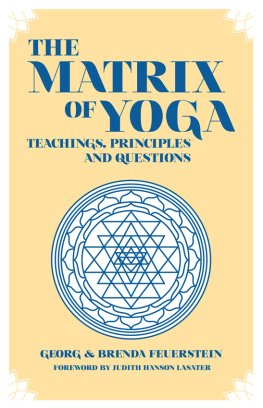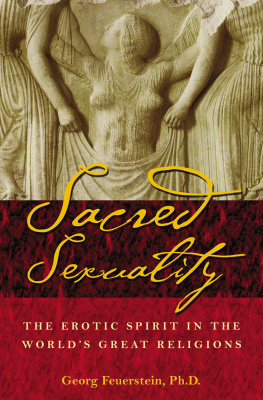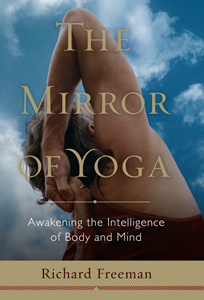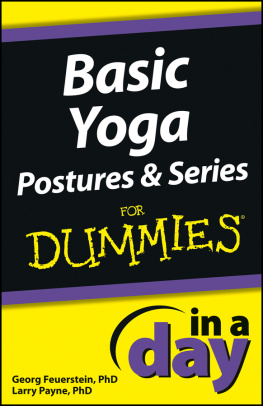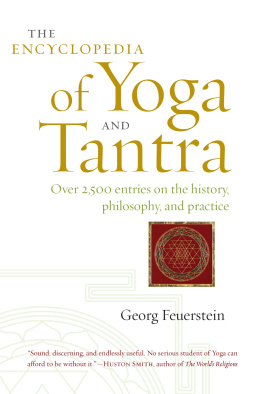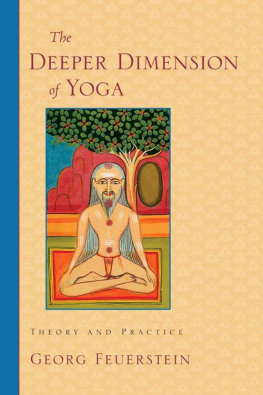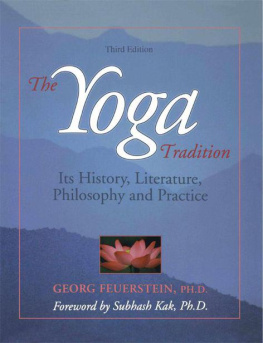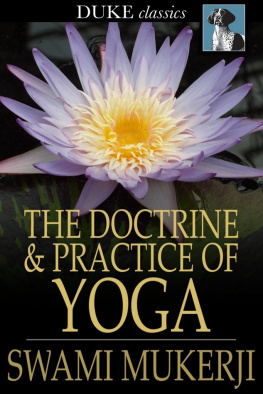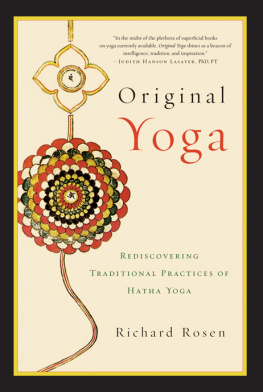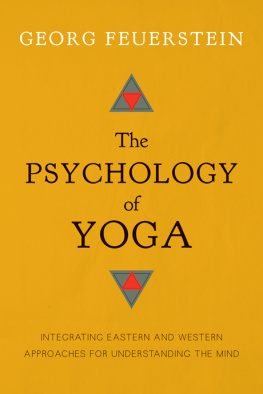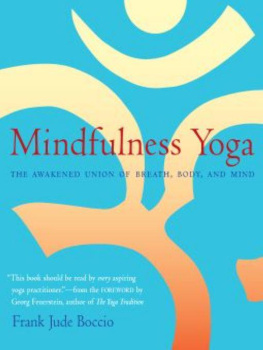Appendix A: Guide to Sanskrit Pronunciation
Sanskrit is a difficult language to learn and one that, at least for most Westerners, is virtually impossible to master. The pronunciation of its rich vocabulary with its strange sounds is just as difficult. Scholars devised a variety of transliteration schemes to indicate the correct sound of each letter of the alphabet. Then, at a conference of Orientalists held in Athens in 1912, the Sanskrit transliteration was standardized and has been in use since.
We have not availed ourselves of the academic or even simplified transliteration of Sanskrit terms in the present book, which is intended for the complete novice. But in Georgs other books, he has used either full academic or simplified transliteration. The latter recognizes merely the long vowel sounds: , , and . You might bear this in mind. So, dont be surprised when you see yogini (rather than simply yogini ) or asana (rather than simply asana ) for a physical posture in some books.
All vowels are to be pronounced open, like in Italian or Latin. Thus, yoga is pronounced with an o, as in short. The commonly used word cakra, which means wheel, is pronounced tshakra rather than shakra. The word mandala, or circle, is pronounced with short a -sounds, and the emphasis is on the first syllable, not like mandahla, with a long middle a that is emphasized.
A common mispronunciation concerns the word Hatha-Yoga. The th -sound is not at all like the English th in this or that. Rather, all consonants followed by an h are to be pronounced distinctly as aspirates, as in top-heavy. Consequently, Hatha is properly pronounced at Hat-ha (whereby the first a is similar to the a -sound in hut, not as in hand). The common word phala, or fruit, is pronounced p-hala, not fala, and kapha (phlegm) is pronounced kap-ha and not kafa. These explanations should help you avoid the worst blunders.
Appendix B: What to Read and Study Next?
With an assortment of Georgs books on Yoga in print, many students are wondering just how to proceed most sensibly with studying his work. This appendix aims at answering the above question.
If you are unfamiliar with the philosophical and spiritual basis of Yoga, which is our primary concern, and are mainly interested in practicing the physical techniques, we suggest that you begin with Yoga For Dummies Second Edition, which is coauthored with California Yoga teacher Larry Payne. First published in 1999, this book has served more than 100,000 readers thus far.
When the original publisher (IDG Books) first invited Georg to write this book, he declined without any hesitation. He had his plate full, and he also felt neither interested nor particularly qualified to produce a popular work that would focus on postures. But, to her credit, the acquisitions editor at the time persisted and approached Georg twice more. He thought that her invitation deserved at least his genuine consideration, and it occurred to him that this book would give him an opportunity to at least briefly present the spiritual aspects of Yoga to a wide readership. So, in the end, he agreed to take on this project. He was able to enlist Larry Payne, who has taught the physical techniques over many years, as his collaborator.
In 2009, Larry and Georg were asked by the new publisher (Wiley) to revise the book. Although they both felt that, apart from some minor corrections, it was not in need of revision, they complied with the request. The second edition, published two years later, is again a reliable and easily understandable guide.
If you have read Yoga For Dummies and find yourself drawn to the philosophical-spiritual side of Yoga, we can next recommend that you start your further exploration with The Teachings of Yoga an anthology published by Shambhala in 1997 or with Gems of Yoga, which is a similar book published by Bantam House in 2002. Alternatively, you might want to listen to Georgs CD Yoga Wisdom or the CD set (of six CDs) entitled The Lost Teachings of Yoga, both published by Sounds True.
Next, at a slightly more demanding level, there is the book The Path of Yoga (formerly The Shambhala Guide to Yoga ), published in a revised edition in 2011. You might then want to turn to The Deeper Dimension of Yoga, also released by Shambhala in 2003. This book contains seventy-eight essays, which are reasonably simple-to-understand. Which written over many years, they address a wide range of topics. Arranged in five parts, the essays gradually take you from simple, orienting materialssuch as What is Yoga? and Forty Types of Yogato essays on spiritual practice, to considerations about the moral foundation of Yoga, more demanding treatments of the spectrum of Yoga practice, and, finally, to essays on the higher stages of Yoga, such as meditation, prayer, ecstasy, the enigmatic serpent-power ( kundalin-shakti ), and spiritual liberation.
Yoga: The Deeper Dimension makes an excellent platform for delving into The Yoga Tradition, which is a large-size, illustrated volume of well over 500 pages with a foreword by Professor Subhash Kak. It has been called the Yoga telephone book by some students, and we can see why. It covers a huge territory and was designed to be used as a comprehensive (though by no means exhaustive) reference work. First published in 1998, this book grew out of Georgs Yoga: The Technology of Ecstasy, which is no longer in print. A revised and expanded edition of The Yoga Tradition was published in 2008. This volume consists of eighteen chapters arranged in four parts, and it includes his translation of several major Sanskrit texts on Yoga, notably Patanjalis Yoga-Sutra, as well as selections from other texts.
The Yoga-Sutra is an important text, and in the West is the most studied of all the Sanskrit works on Yoga. Georg translated this text twice: First in his book The Yoga-Sutra of Patanjali, published in 1979 and reissued in 1989 by Inner Traditions, and second in his recent book The Yoga-Sutra: A Nondualist Interpretation. Both works have been released as e-books in 2011 by Traditional Yoga Studies. The latter publication includes detailed grammatical information for those wishing to study this text in the original.
Those wishing to delve yet deeper into the ocean of Yoga may want to participate in Georgs 800-hour distance-learning course accompanying The Yoga Tradition. The course comprises nearly 1000 pages, which together with the book represents a small library of several volumes. Thus far, several hundred students from around the world have braved this course, and many have graduated with a certificate of completion. This course represents the culmination of Georgs publications that aim to give Yoga enthusiasts a thorough overview of the philosophy, history, and literature of Yoga covering a period of 5,000 years. We are constantly trying to make the study of this work more accessible, so that students can benefit from it spiritually.
Our other distance-learning courses, all written by Georg, go into more detail on certain aspects addressed in the 800hour course. Thus, the 250-hour, 380-page course entitled The Foundations of Yoga deals with the materials found in Chapters 1-8 in his book The Yoga Tradition. There is also a 250-hour, 380-page course entitled Classical Yoga, which expands on Chapters 9 and 10, and is based on his translation of Patanjalis text. The 125-hour, 305-page course entitled The Bhagavad-Gita expands on his recent translation of, and commentary on, this widely read work, published in 2011 by Shambhala. Finally, a 250-hour course on the philosophy and theory of Hatha-Yoga is in preparation.
At some point along this route of self-study, students of Georgs work might want to acquire a copy of his Encyclopedia of Yoga and Tantra, which is the 2011 revised and expanded edition of his Shambhala Encyclopedia of Yoga. The new version contains well over 2,000 entries and should meet most readers lexicographic needs or curiosity.

